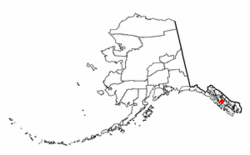Kake, Alaska facts for kids
Quick facts for kids
Kake, Alaska
Ḵéex̱ʼ
|
||
|---|---|---|
|
||

Location in Alaska
|
||
| Country | United States | |
| State | Alaska | |
| Census Area | Prince of Wales-Hyder | |
| Incorporated | November 3, 1951 | |
| Area | ||
| • Total | 13.51 sq mi (34.98 km2) | |
| • Land | 7.67 sq mi (19.87 km2) | |
| • Water | 5.83 sq mi (15.11 km2) | |
| Elevation | 56 ft (17 m) | |
| Population
(2020)
|
||
| • Total | 543 | |
| • Density | 70.77/sq mi (27.32/km2) | |
| Time zone | UTC-9 (Alaska (AKST)) | |
| • Summer (DST) | UTC-8 (AKDT) | |
| ZIP code |
99830
|
|
| Area code | 907 | |
| FIPS code | 02-36770 | |
| GNIS feature ID | 1422926, 2419403 | |
Kake (pronounced like 'cake') is a city in Prince of Wales-Hyder Census Area, Alaska, United States. In 2020, about 543 people lived there. The name Kake comes from the Tlingit words ḵée and x̱ʼé, which together mean 'mouth of dawn' or 'opening of daylight'.
| Top - 0-9 A B C D E F G H I J K L M N O P Q R S T U V W X Y Z |
Where is Kake located?
Kake is found on the northwest coast of Kupreanof Island. This island is part of the Alexander Archipelago in southeastern Alaska. The city covers about 14.2 square miles (36.8 square kilometers). A large part of this area, about 6.0 square miles (15.5 square kilometers), is water.
How many people live in Kake?
| Historical population | |||
|---|---|---|---|
| Census | Pop. | %± | |
| 1880 | 261 | — | |
| 1910 | 232 | — | |
| 1920 | 387 | 66.8% | |
| 1930 | 386 | −0.3% | |
| 1940 | 419 | 8.5% | |
| 1950 | 376 | −10.3% | |
| 1960 | 455 | 21.0% | |
| 1970 | 448 | −1.5% | |
| 1980 | 555 | 23.9% | |
| 1990 | 700 | 26.1% | |
| 2000 | 710 | 1.4% | |
| 2010 | 557 | −21.5% | |
| 2020 | 543 | −2.5% | |
| U.S. Decennial Census | |||
Kake was first counted in the U.S. Census in 1880 as a Tlingit village. It officially became a city in 1951.
In 2000, there were 710 people living in Kake. Most households had families, and many had children under 18. The average age of people in Kake was 32 years old.
What is Kake's history?
Early History of Kake
The area around Kake has been home to the Tlingit people for thousands of years. They are an indigenous group of Alaska. Early European and American explorers heard that the Tlingit people of Kake were very strong.
Some explorers visited Kake in the early 1800s. They came looking for sea otter skins for trade. The Russian Golovin Expedition also visited in 1818. An artist from that trip even painted a picture of a Tlingit chief named Kotlean.
Kake after Alaska became part of the U.S.
In 1869, there was a conflict known as the Kake War. During this time, a U.S. Navy ship destroyed three empty villages and two forts near where Kake is today. This happened after two white trappers were killed by Kake people. This was in response to the death of two Kake people near Sitka.
No Kake people died during the destruction of the villages, but some died later that winter. This was because they lost their homes, food, and canoes. The villages were not rebuilt. The people moved to other places or stayed nearby and eventually rebuilt the Kake we know today.
On September 25, 2024, the U.S. Navy formally apologized to the people of Kake for what happened.
Kake is also famous for having a very tall totem pole. It is 128 feet high, making it one of the largest in the world. It was carved in 1967 to celebrate 100 years since the Alaska Purchase.
Education in Kake
The Kake City School District is in charge of the school in the city.
Who are some famous people from Kake?
- Edna Jackson (born 1950), an artist
See also
 In Spanish: Kake (Alaska) para niños
In Spanish: Kake (Alaska) para niños


